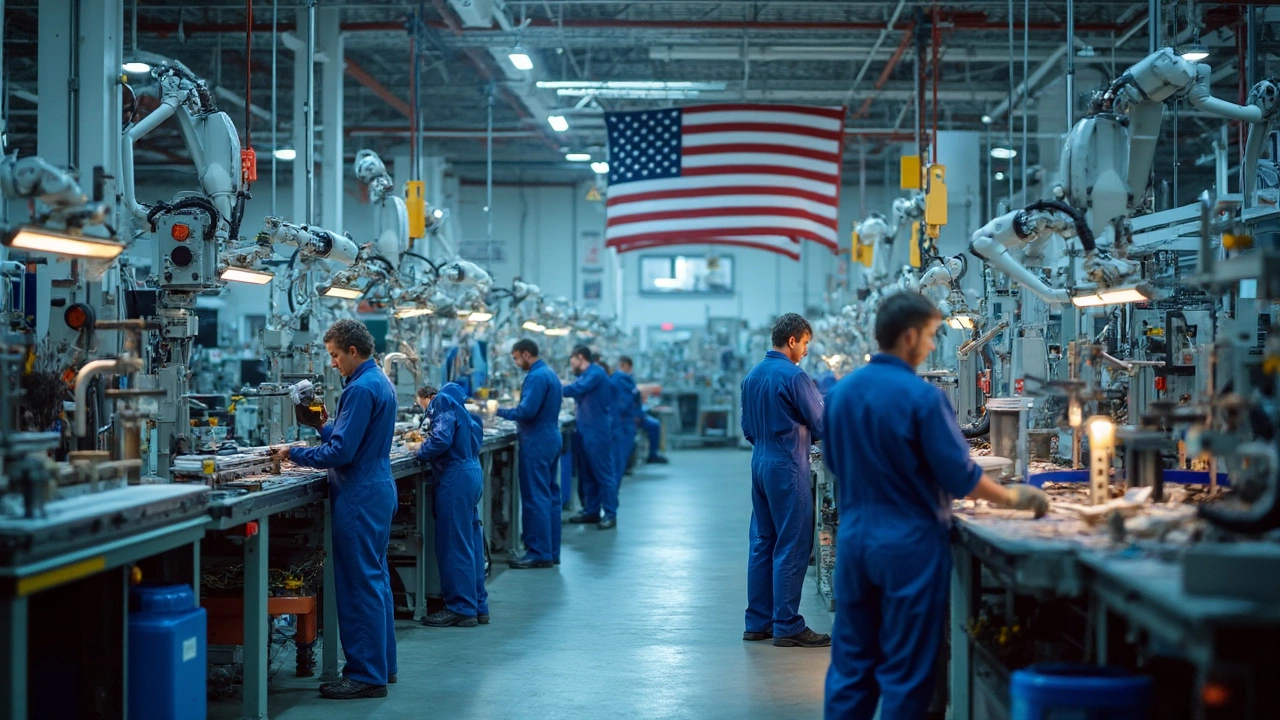Have you ever wondered how the US stacks up in the global manufacturing scene? You might be surprised to learn that the United States holds a prominent position, often touted as one of the top players globally. But it's not just about sheer output. It's a mix of innovation, efficiency, and some good old-fashioned hard work.
The US manufacturing industry is a powerhouse, pivoting on sectors like technology, aerospace, and automotive. Giants like General Electric and Boeing are not just names; they're symbols of American industrial prowess. But, with rapid advancements and fierce global competition, how does the US maintain its edge? It’s partly due to relentless innovation and adaptability.
Despite challenges, like supply chain issues and labor concerns, manufacturing in the US continues to thrive. Understanding this landscape is vital if you're interested in business, technology, or just curious about what makes the US manufacturing tick. So, how's the US actually doing? Let's dive deeper and unravel some of the industry's most fascinating layers.
- US Manufacturing Rank
- Top US Manufacturing Companies
- Technological Innovations
- Challenges and Future Prospects
US Manufacturing Rank
The US manufacturing sector ranks as the second-largest in the world, just behind China. It's pretty impressive, considering the scale and diversity of industries that fall under this umbrella. The US accounts for about 18% of the industry's total output globally, showcasing its significant role in the world economy.
Global manufacturing rankings aren't just about size, though. They consider factors like productivity, technological advancement, and the ability to innovate. The US scores high on all these fronts, thanks to its robust infrastructure and skilled workforce. The country is a leader in advanced manufacturing technologies, including automation and artificial intelligence, which helps keep its industries competitive.
Breaking Down the Numbers
It's fascinating to see how various sectors contribute to the US's position. For instance, the automotive industry, with companies like Ford and General Motors, contributes significantly to the manufacturing output. Similarly, the aerospace sector, led by giants like Boeing, plays a crucial role in maintaining America's top-tier status.
| Sector | Contribution to Output (%) |
|---|---|
| Automotive | 14% |
| Aerospace | 11% |
| Electronics | 10% |
But it's not all smooth sailing. The manufacturing industry in the US faces its share of challenges, ranging from global competition to supply chain issues. Yet, the focus on innovation and adaptability helps the US maintain its stronghold.
In summary, the US's rank in the manufacturing realm isn't just about numbers. It's about being a leader in technology, efficiency, and continuous improvement. This dynamic landscape keeps the US not just participating, but leading in the global stage of manufacturing.
Top US Manufacturing Companies
When it comes to US manufacturing, several big names hit the spotlight, making a mark not just domestically, but globally. These companies are not only churning out enormous production volumes but also driving innovation across various industries.
General Electric (GE)
GE has long been a stalwart in the manufacturing sector. Known for its diverse portfolio ranging from renewable energy and aviation to healthcare, GE exemplifies innovation. They continually push the boundaries, focusing on sustainable solutions, making them a prominent player in the manufacturing industry.
Boeing
Think flying, think Boeing. As a leading aerospace manufacturer, Boeing is a key contributor to America’s global manufacturing reputation. Despite facing hurdles like production delays, Boeing's expertise in aircraft manufacturing keeps them at the forefront.
Caterpillar Inc.
In construction equipment, Caterpillar is a name that resonates around the world. Specializing in heavy machinery, their products are vital for infrastructure developments. Caterpillar has perfected its operations efficiency, placing it among the top manufacturing companies.
Apple
While popularly known for its sleek gadgets, Apple is a manufacturing giant, leveraging cutting-edge technology and design. Apple's strategic supply chain management ensures it maintains a competitive edge, particularly in electronics manufacturing.
These companies not only lead the charge in their respective fields but also significantly contribute to the United States' position in global manufacturing standings. Their constant adaptation to technology and market needs symbolizes the robustness of American manufacturing.
Considering these industry leaders, it's clear that the US has a stronghold in manufacturing thanks to these company's innovations, resilience, and ability to stay ahead of global trends.

Technological Innovations
Technology is reshaping the US manufacturing landscape, with some mind-blowing innovations making headlines. Now, don't think it's just about fancy robots at assembly lines. It's about smart decisions and game-changers.
The Rise of Automation
We're talking automation, and not just any automation. Companies are using AI and machine learning to optimize processes and make manufacturing faster and more efficient. With intelligent systems, factories are now capable of predicting maintenance needs before machines go kaput, saving a ton of downtime.
3D Printing: Not Just for Prototypes
3D printing isn't just about building snazzy prototypes anymore. It's making waves in top US manufacturing companies by allowing for personalized products and reducing waste. Imagine creating a fully functional jet engine part on-demand — that's not sci-fi, it's today's reality.
Internet of Things (IoT)
The Internet of Things is like the nerve center for smart manufacturing. We're seeing factories become interconnected hubs, where sensors and devices communicate to streamline operations. This connectivity boosts productivity and keeps operations smooth.
| Year | Investment in Automation (Billion USD) |
|---|---|
| 2021 | 5.4 |
| 2023 | 7.9 |
| 2025 | 10.5 |
These numbers reflect the growing trust and investment in automation, emphasizing its undeniable importance in the evolving manufacturing scene.
So, with innovations like these, the US isn't just keeping up — it's leading the pack. These advancements aren't only boosting productivity but also reshaping how we think about manufacturing altogether. And that's how technological innovations are transforming our industry, making it more dynamic, efficient, and forward-thinking.
Challenges and Future Prospects
The US manufacturing industry isn't without its hurdles. Supply chain disruptions have been a massive headache, especially in the past few years. The pandemic threw a wrench in the works, reminding everyone how interdependent global manufacturing really is.
A major concern is the shortage of skilled labor. As manufacturing processes become more automated, the demand for tech-savvy workers increases. Training workers to transition from traditional methods to high-tech ones isn't an overnight fix.
The Manufacturing Institute states, "By 2030, 2.1 million manufacturing jobs could go unfilled due to a lack of skilled workers."
Automation is a double-edged sword. On one hand, it's great for increasing efficiency. On the other, it raises worries about job losses. Striking the right balance is key.
Future Prospects
So, where's the silver lining for US manufacturing? It's all about innovation and adaptation. Companies are increasingly investing in sustainable practices, which, truth be told, aren't just trendy but crucial for long-term success.
Advanced technology trends like AI and the Internet of Things (IoT) are shaping the future. These technologies not only optimize production but also improve product quality. Imagine a system where machines communicate and diagnose issues before they cause downtime.
Global manufacturing rankings are fueled by these innovations. There's a concerted shift toward embracing Industry 4.0, with smart factories becoming more of a reality than a buzzword.
| Year | Projected Manufacturing Output Increase |
|---|---|
| 2025 | 15% |
| 2030 | 25% |
For the US to maintain its competitive edge, government and private sectors need to collaborate on policies that promote growth. Investments in education and infrastructure will play a big role in filling the skills gap and boosting productivity.
So, while challenges loom, the prospects look promising. The key takeaway? Stay innovative, stay agile, and never stop evolving.
